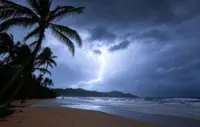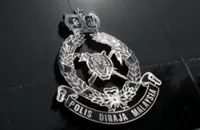
Tough reality: Kamarul (left) and Lee travelled to Ukraine in 2014 to cover the downing of flight MH17 in this filepic.
PETALING JAYA: Ten years on, memories of the ground coverage of the debris field from the destroyed MH17 are still vivid in the minds of Patrick Lee and Kamarul Ariffin from The Star.
Lee, then a journalist with The Star, recounted his experience being the first Malaysians alongside photographer Kamarul to cover flight MH17, an aircraft of Malaysia Airlines that was shot down over conflict-hit eastern Ukraine on July 17, 2014.
All 298 people on board, including 43 Malaysian passengers and crew members, were killed.
Lee, 40, said he was first surprised that he was chosen to cover the crash site when the then chief news editor, Devid Rajah, told him to travel to Ukraine.
“I initially thought if anyone would cover the site, it would be my seniors, such as Shahanaaz Habib, who had more experience in covering conflicts and war zones,” he said when contacted yesterday.
Lee and Kamarul, then an assistant chief photographer, spent two weeks in the region to bring coverage of not just the crash but also the ongoing conflict between Russia and Ukraine.
Lee described his experience as surreal, with the conflict between Russia and Ukraine still in its infancy but showing signs of escalation.
Donetsk was occupied by the Russian separatist forces, so Lee had to find a way to travel there from Dnipro, which was under Ukraine.
“When we landed from Istanbul to the nearest city, Dnepropetrovsk (now known as Dnipro), we had to travel about four hours on train to Donetsk.
“Interestingly, the train travelled to Donetsk even though the conflict was ongoing. The ride only cost us less than RM10. The whole trip was peaceful on the way there, which was strange considering the ongoing conflict,” he added.
On the train, Lee received a call from a fixer telling him that there was active gunfire at the station that was 30 minutes away from Donetsk station.
When they arrived at the station, the duo witnessed the conflict firsthand, as gunshots rang out, causing commotion among the passengers who wanted to flee.
The Donetsk People’s Republic soldiers then escorted the train passengers to a nearby underground tunnel for protection before they later left the area using buses, according to Lee.
Upon arriving in Donetsk, Lee and Kamarul found out they were the only two Malaysians to arrive at the scene, apart from journalists from international media.
They were given press passes by the separatists and brought to their heavily guarded headquarters to interview their leader.
“When I put on the ballistic jacket in front of the soldiers, one of the guards pointed his rifle at me and said something before laughing.
“When I asked my fixer what he said, the soldier was saying that if he shot me, the bullet would go through anyway,” he said as he recalled that memorable incident.
Lee quickly defused the tension by offering the soldier a cigarette he had brought from Malaysia.
After visiting the debris field strewn with bits and pieces from the destroyed aircraft, Lee said he was met with widespread sympathy from the residents there.
“When they found out that we were from Malaysia, they expressed their condolences. I finally experienced a flood of emotions at that point,” he said.
Kamarul, 55, said he can still remember the stench at the crash site when they arrived.
“We arrived just hours after the bodies were collected, and it had this strong smell – one that still lingers on my mind,” he said.
Kamarul also shared that he had a “mystical experience” while taking pictures at the site.
A child’s loud crying startled him while he was taking photos. At the same moment, he saw a pair of Hello Kitty shoes, a popular Japanese cartoon character.
“However, there was a clear absence of people, especially children.
“I still get goosebumps whenever we talk about it,” he added.
Kamarul, an experienced photographer with a background in reporting from war zones, said that memories of MH17 would resurface whenever he encountered anything associated with Hello Kitty.
“Whenever I see a Hello Kitty image, I am transported back to the crash site. It is the same with bananas. I gave my own supply of fruit to a starving child while covering the Libyan war.
“The image and the incident will always remain etched in my memory,” he said.
When asked if he would ever return to the region, Kamarul said he was lucky to have survived unscathed.
“Given the possibility that soldiers may have targeted us or that we encountered hostility in the places we visited, I consider myself fortunate and do not wish to return,” he stated.
Lee, who is now a media freelancer, said covering the MH17 crash up close proved to be a life-changing event.
“It definitely recharged my love for journalism, made me push myself career-wise, and gave me the sense that there is more than just covering run-of-the-mill stuff,” he said.











































